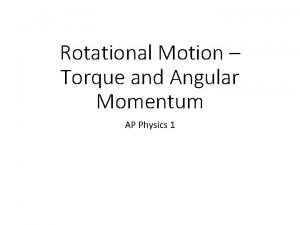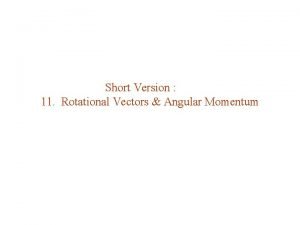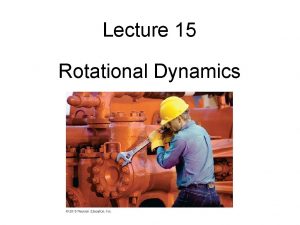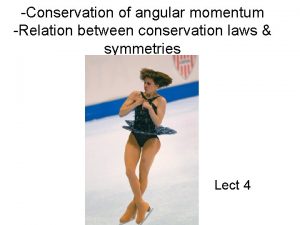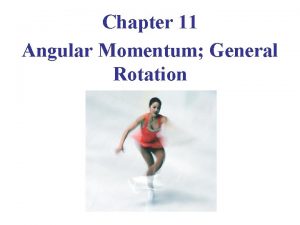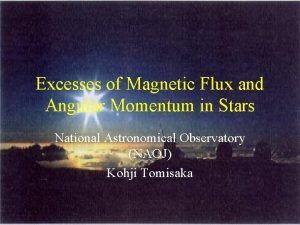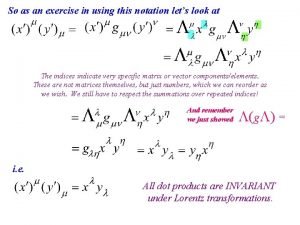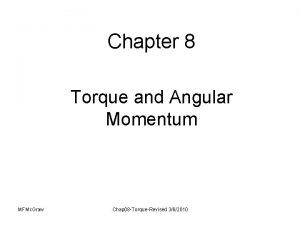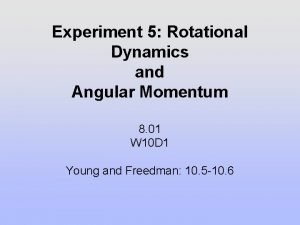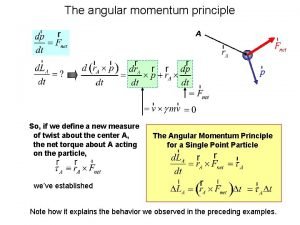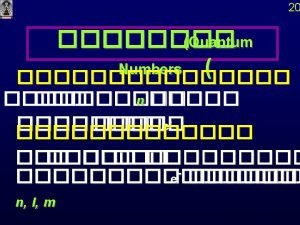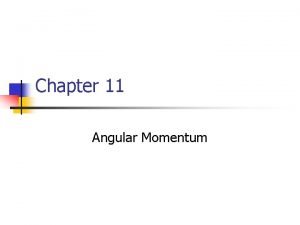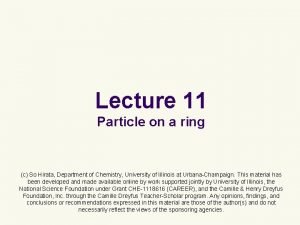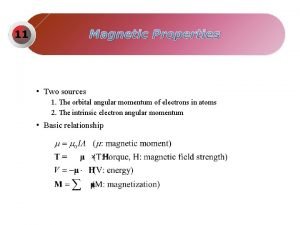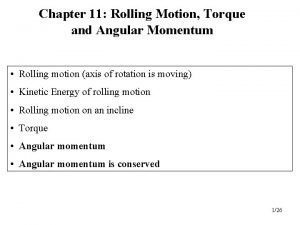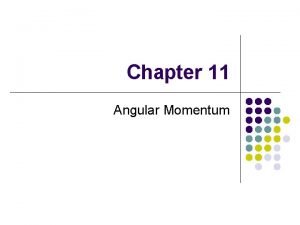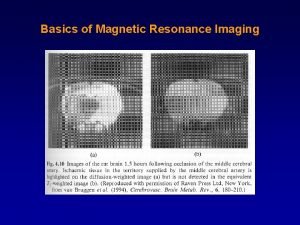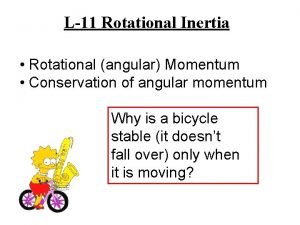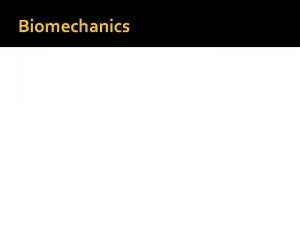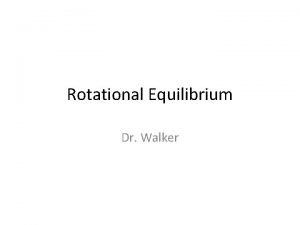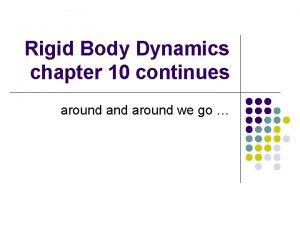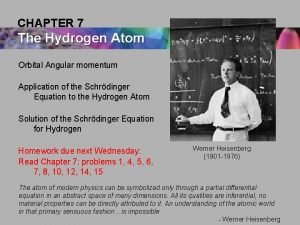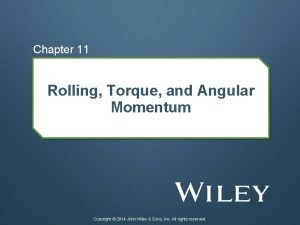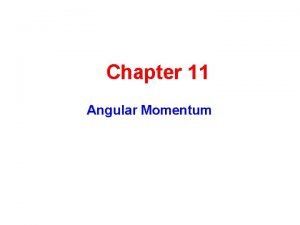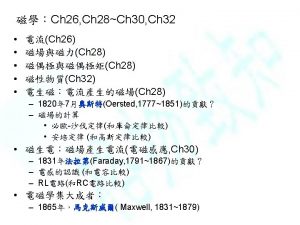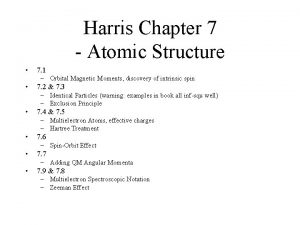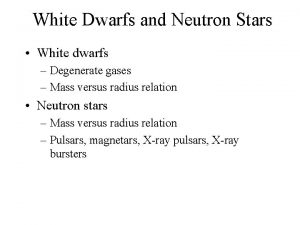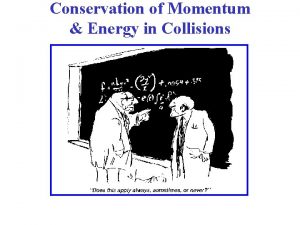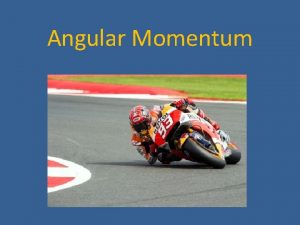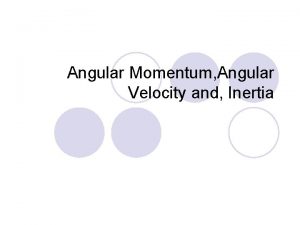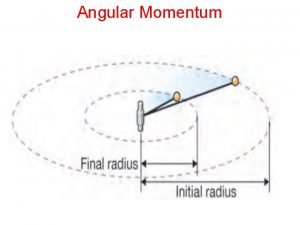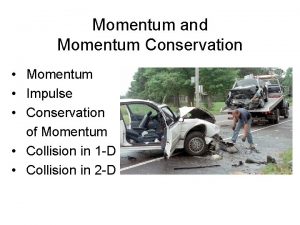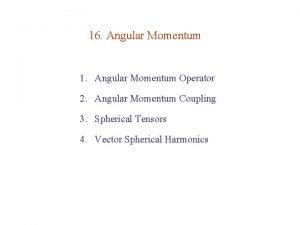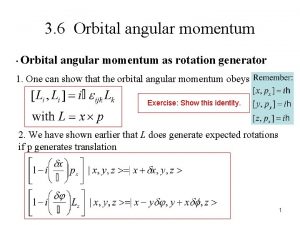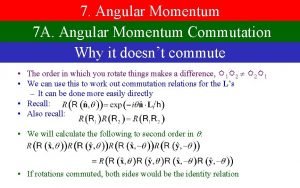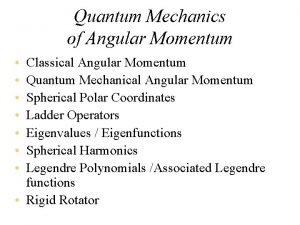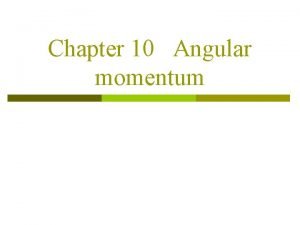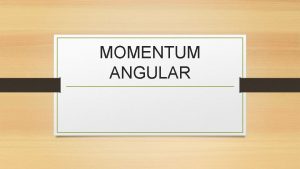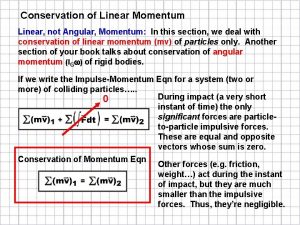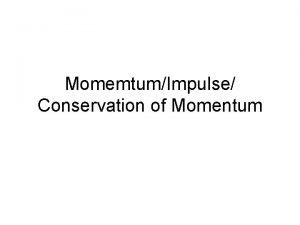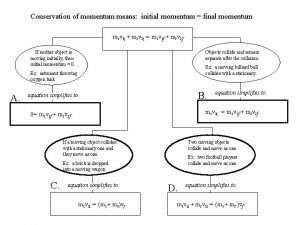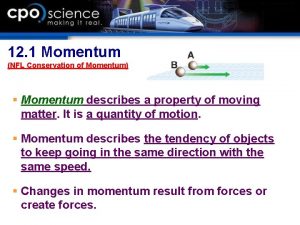Conservation of Angular Momentum 8 01 W 11




























- Slides: 28

Conservation of Angular Momentum 8. 01 W 11 D 2 Fall 2006

Time Derivative of Angular Momentum for a Point Particle Time derivative of the angular momentum about S: Product rule Key Fact: Result:

Torque and the Time Derivative of Angular Momentum Torque about a point S is equal to the time derivative of the angular momentum about S.

Angular Momentum for a System of Particles Treat each particle separately Angular momentum for system about S

Angular Momentum and Torque for a System of Particles Change in total angular momentum about a point S equals the total torque about the point S

Internal and External Torques The total external torque is the sum of the torques due to the net external force acting on each element The total internal torque arise from the torques due to the internal forces acting between pairs of elements The total torque about S is the sum of the external torques and the internal torques

Internal Torques We know by Newton’s Third Law that the internal forces cancel in pairs and hence the sum of the internal forces is zero Does the same statement hold about pairs of internal torques? By the Third Law this sum becomes The vector points from the jth element to the ith element.

Central Forces: Internal Torques Cancel in Pairs If the internal forces between a pair of particles are directed along the line joining the two particles then the torque due to the internal forces cancel in pairs. This is a stronger version of Newton’s Third Law than we have so far used requiring that internal forces are central forces. With this assumption, the total torque is just due to the external forces However, so far no isolated system has been encountered such that the angular momentum is not constant.

Conservation of Angular Momentum Rotational dynamics No external torques Change in Angular momentum is zero Angular Momentum is conserved So far no isolated system has been encountered such that the angular momentum is not constant.

Concept Question : Figure Skater A figure skater stands on one spot on the ice (assumed frictionless) and spins around with her arms extended. When she pulls in her arms, she reduces her rotational moment of inertia and her angular speed increases. Assume that her angular momentum is constant. Compared to her initial rotational kinetic energy, her rotational kinetic energy after she has pulled in her arms must be 1. the same. 2. larger because she's rotating faster. 3. smaller because her rotational moment of inertia is smaller.

Group Problem : Rotating Chair and Wheel A person is sitting on a chair that is initially not rotating and is holding a spinning wheel. The moment of inertia of the person and the chair about a vertical axis passing through the center of the stool is IS, p. The moment of inertia of the wheel about an axis, perpendicular to the plane of the wheel, passing through the center of mass of the wheel is Iw= (1/4)IS, p. The mass of wheel is mw. Suppose that the person holds the wheel as shown in the sketch such that the distance of an axis passing through the center of mass of the wheel to the axis of rotation of the stool is d and that md 2 = (1/3)Iw. Suppose the wheel is spinning initially at an angular speed s. The person then turns the spinning wheel upside down. You may ignore any frictional torque in the bearings of the stool. What is the angular speed of the person and stool after the spinning wheel is turned upside down?

Demo: Rotating Wheel Bicycle Wheel and Rotating Stool

Demo: Train (1) At first the train is started without the track moving. The train and the track both move, one opposite the other. (2) Then the track is held fixed and the train is started. When the track is let go it does not revolve until the train is stopped. Then the track moves in the direction the train was moving. (3) Next try holding the train in place until the track comes up to normal speed (Its being driven by the train). When you let go the train remains in its stationary position while the track revolves. You shut the power off to the train and the train goes backwards. Put the power on and the train remains stationary. A small gauge HO train is placed on a circular track that is free to rotate.

Angular Impulse and Change in Angular Momentum Angular impulse Change in angular momentum Rotational dynamics

Constants of the Motion When are the quantities, angular momentum about a point S, energy, and momentum constant for a system? • No external torques about point S : angular momentum about S is constant • No external work: mechanical energy constant • No external forces: momentum constant

Concept Question: Conservation Laws A tetherball of mass m is attached to a post of radius by a string. Initially it is a distance r 0 from the center of the post and it is moving tangentially with a speed v 0. The string passes through a hole in the center of the post at the top. The string is gradually shortened by drawing it through the hole. Ignore gravity. Until the ball hits the post, 1. The energy and angular momentum about the center of the post are constant. 2. The energy of the ball is constant but the angular momentum about the center of the post changes. 3. Both the energy and the angular momentum about the center of the post, change. 4. The energy of the ball changes but the angular momentum about the center of the post is constant.

Concept Question: Conservation laws A tetherball of mass m is attached to a post of radius R by a string. Initially it is a distance r 0 from the center of the post and it is moving tangentially with a speed v 0. The string wraps around the outside of the post. Ignore gravity. Until the ball hits the post, 1. The energy and angular momentum about the center of the post are constant. 2. The energy of the ball is constant but the angular momentum about the center of the post changes. 3. Both the energy of the ball and the angular momentum about the center of the post, change. 4. The energy of the ball changes but the angular momentum about the center of the post is constant.

Concept Question: Streetcar A streetcar is freely coasting (no friction) around a large circular track. It is then switched to a small circular track. When coasting on the smaller circle the streetcar's 1. mechanical energy is conserved angular momentum about the center is conserved 2. mechanical energy is not conserved angular momentum about the center is conserved 3. mechanical energy is not conserved angular momentum about the center is not conserved 4. mechanical energy is conserved angular momentum about the center is not conserved.

Experiment 06: Angular Collisions

Apparatus q Connect output of phototransistor to channel A of 750. q Connect output of tachometer generator to channel B of 750. q Connect power supply. q Red button is pressed: Power is applied to motor. q Red button is released: Rotor coasts: Read output voltage using Lab. VIEW program. q Use black sticker or tape on white plastic rotor for generator calibration.

Calibrate Tachometergenerator Spin motor up to full speed, let it coast. Measure and plot voltages for 0. 25 s period. Sample Rate: 5000 Hz. Count rotation periods to measure ω. Program calculates average output voltage, angular velocity, and the calibration factor angular velocity per volt periods. 21

Measure IR: results Reset sample rate: 500 Hz and 4 s, Switch from Tachometer to Moment of Inertia. Measure and fit best straight line to get α 1, α 2, and IR:

Experiment 06: Goals Investigate conservation of angular momentum and kinetic energy in rotational collisions. Measure and calculate non-conservative work in an inelastic collision. Keep a copy of your results for the homework problem.

Slow Collision Sample Rate Start Time 2000 Hz 4 sec Find ω1 and ω2 , measure δt , fit to find 1, R , 2. Calculate

Slow Collision Angular momentum: at t 1 + δt: Change in Angular momentum: Angular Impulse:

Slow Collision Angle rotated through by rotor: Angle rotated through by washer: Angle washer slid along rotor:

Fast collision Sample Rate Start Time 2000 Hz 4 sec Find ω1 (before) and ω2 (after), estimate δt for collision. Calculate

Fast collision Angular momentum: at t 1 + δt: Change in Angular momentum: Change in Kinetic Energy: Kinetic energy at dip:
 Angular momentum theorem
Angular momentum theorem Conservation of angular momentum
Conservation of angular momentum Tangential torque
Tangential torque Law of conservation of angular momentum
Law of conservation of angular momentum Momentum
Momentum 5b¹0
5b¹0 Commutation relation in quantum mechanics
Commutation relation in quantum mechanics Angular momentum right hand rule
Angular momentum right hand rule Linear momentum in circular motion
Linear momentum in circular motion Angular momentum principle
Angular momentum principle Angular momentum quantum number
Angular momentum quantum number Relative angular momentum
Relative angular momentum Boundary condition for a particle on a ring is
Boundary condition for a particle on a ring is Gyromagnetic ratio formula
Gyromagnetic ratio formula Angular momentum unit
Angular momentum unit L
L Angular momentum mri
Angular momentum mri Inertia
Inertia Angular momentum biomechanics
Angular momentum biomechanics Equation for torque and angular velocity
Equation for torque and angular velocity Rigid body rotation formula
Rigid body rotation formula Angular momentum quantum number
Angular momentum quantum number Rolling torque and angular momentum
Rolling torque and angular momentum Torque and angular momentum
Torque and angular momentum Angular momentum of ball
Angular momentum of ball Orbital angular momentum
Orbital angular momentum Orbital angular momentum
Orbital angular momentum Crab nebula neutron star
Crab nebula neutron star Perfectly inelastic collision definition
Perfectly inelastic collision definition
